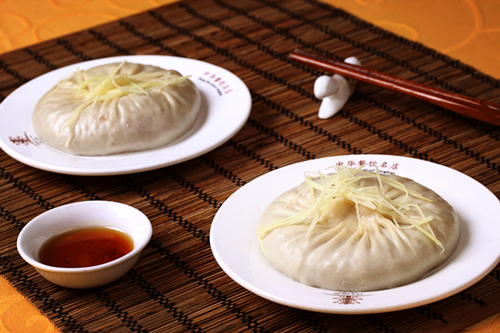
Yangzhou Steamed Dumpling features thin wrappers and plump shape. [Photo provided to seeyangzhou.com]
The influences of culture and history on food traditions are felt in every locale in Yangzhou, Jiangsu province.
Yangzhou is a traditional center of Huaiyang cuisine, one of China's four major cooking styles. It is famous for its light, fresh taste and exquisite cuts, and now many time-honored restaurants, including Yechun and Fuchun teahouses, have become must-visit spots for tourists who want to have a taste of authentic Yangzhou flavors.
Locals follow the practice of "skin wraps water in the morning, and water wraps skin in the evening", that is, to eat steamed buns and tea in the morning, and to enjoy time in bathhouses at evening.
The city's signature breakfast is often composed of crab-roe soup dumplings, sanding bao (steamed bun stuffed with diced pork, chicken and bamboo shoots), jade-colored steamed dumplings that are stuffed with green vegetables, and qianceng cake, literally thousand-layer cake. All are very delicious, especially when accompanied with a cup of green tea.
Yangzhou steamed buns or dumplings use a traditional method to ferment wheat flour dough, in order to make the skin of the buns and dumplings soft but chewy. Qianceng cake, which tastes slightly sweet and is soft as cotton, even once it becomes cold.
The pickled mushroom with shrimp paste is also good, with its chewy, meaty and juicy texture, and savory flavor.
Tang gansi, or boiled scaly tofu threads, a famous Huaiyang dish, should also be tried in Yangzhou. Chefs slice tofu into very tiny shreds, then soak the shreds in boiling water before dressing them with specially made seasoning sauce.
It is said that Yangzhou's version of tang gansi sets itself apart from others, because Yangzhou tofu is neither too hard nor soft, and has an aromatic flavor.
Shizitou, or lion-head meatball, is very representative of Huaiyang cuisine. Chefs often use both lean and fatty pork to make the meatball to ensure it is tender and juicy.
Last but not the least, Yangzhou's namesake fried rice speaks to that exquisite cuisine. Traditionally, eight ingredients, including egg, shrimp, corn, ham, mushroom, and carrot are fried together with rice and spices, to make a bowl of refreshingly aromatic fried rice.
Huaiyang cuisine has an honored place in Chinese culture and has been prominent in official dining. It was featured at the first state banquet for the People's Republic of China in 1949, at China's 50th anniversary banquet in 1999, and at a state dinner for then US president George W. Bush hosted by Chinese president Jiang Zemin in 2002.